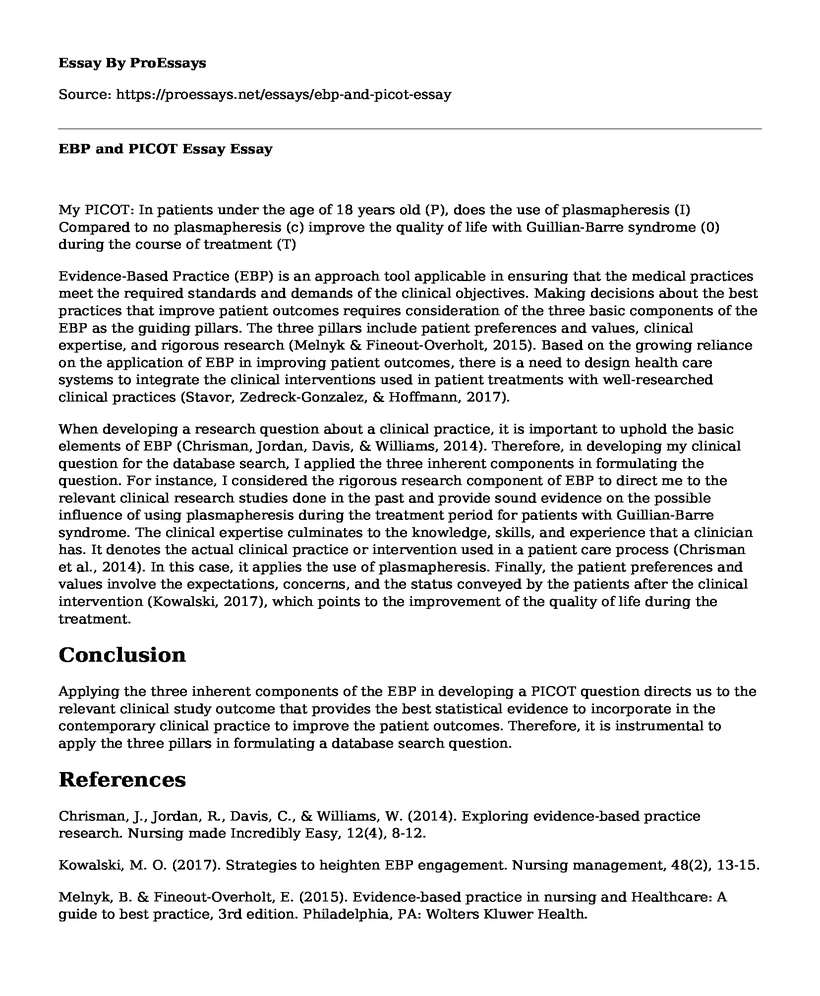My PICOT: In patients under the age of 18 years old (P), does the use of plasmapheresis (I) Compared to no plasmapheresis (c) improve the quality of life with Guillian-Barre syndrome (0) during the course of treatment (T)
Evidence-Based Practice (EBP) is an approach tool applicable in ensuring that the medical practices meet the required standards and demands of the clinical objectives. Making decisions about the best practices that improve patient outcomes requires consideration of the three basic components of the EBP as the guiding pillars. The three pillars include patient preferences and values, clinical expertise, and rigorous research (Melnyk & Fineout-Overholt, 2015). Based on the growing reliance on the application of EBP in improving patient outcomes, there is a need to design health care systems to integrate the clinical interventions used in patient treatments with well-researched clinical practices (Stavor, Zedreck-Gonzalez, & Hoffmann, 2017).
When developing a research question about a clinical practice, it is important to uphold the basic elements of EBP (Chrisman, Jordan, Davis, & Williams, 2014). Therefore, in developing my clinical question for the database search, I applied the three inherent components in formulating the question. For instance, I considered the rigorous research component of EBP to direct me to the relevant clinical research studies done in the past and provide sound evidence on the possible influence of using plasmapheresis during the treatment period for patients with Guillian-Barre syndrome. The clinical expertise culminates to the knowledge, skills, and experience that a clinician has. It denotes the actual clinical practice or intervention used in a patient care process (Chrisman et al., 2014). In this case, it applies the use of plasmapheresis. Finally, the patient preferences and values involve the expectations, concerns, and the status conveyed by the patients after the clinical intervention (Kowalski, 2017), which points to the improvement of the quality of life during the treatment.
Conclusion
Applying the three inherent components of the EBP in developing a PICOT question directs us to the relevant clinical study outcome that provides the best statistical evidence to incorporate in the contemporary clinical practice to improve the patient outcomes. Therefore, it is instrumental to apply the three pillars in formulating a database search question.
References
Chrisman, J., Jordan, R., Davis, C., & Williams, W. (2014). Exploring evidence-based practice research. Nursing made Incredibly Easy, 12(4), 8-12.
Kowalski, M. O. (2017). Strategies to heighten EBP engagement. Nursing management, 48(2), 13-15.
Melnyk, B. & Fineout-Overholt, E. (2015). Evidence-based practice in nursing and Healthcare: A guide to best practice, 3rd edition. Philadelphia, PA: Wolters Kluwer Health.
Stavor, D. C., Zedreck-Gonzalez, J., & Hoffmann, R. L. (2017). Improving the use of evidence-based practice and research utilization through the identification of barriers to implementation in a critical access hospital. Journal of Nursing Administration, 47(1), 56-61.
Cite this page
EBP and PICOT Essay. (2022, May 17). Retrieved from https://proessays.net/essays/ebp-and-picot-essay
If you are the original author of this essay and no longer wish to have it published on the ProEssays website, please click below to request its removal:
- My Career Choice: Nursing Paper Example
- Essay Sample on Exercise Plan for an Older Client With Elderly Falls
- Explanation of the Skin Disorder - Essay Sample
- Essay Sample on Marijuana Use: Debating Mental Health Benefits vs. Risks
- Research Paper on Solutions for People With Disabilities in the Workplace
- Essay on Poor Planning of Community Health Assessment: Devastating Impact
- COVID-19: Adapting to a New Normal With Digital Tools - Essay Sample







